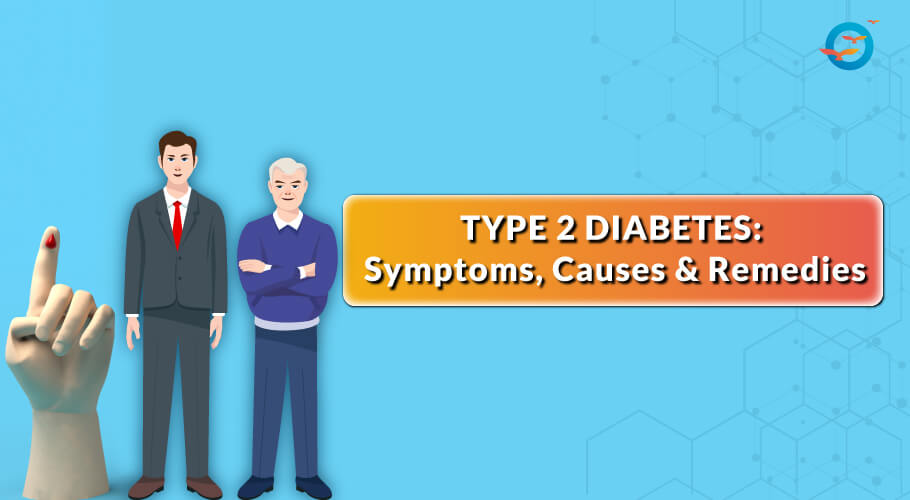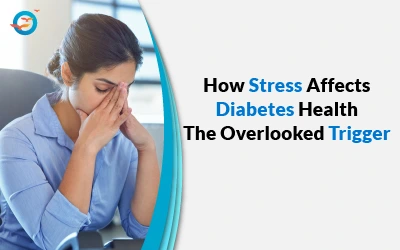Type 2 Diabetes: Symptoms, Causes and treatment - FFD

The International Diabetes Federation (IDF) provides the latest information on diabetes worldwide.
The statistics shared by them are quite alarming like
- 537 million adults ranging between 20-79 years are living with diabetes presently.
- 643 million is the projected rise by 2030.
- Diabetes is no more restricted to high-income countries.
- Diabetes is also one of the major causes of death worldwide
Diabetes mellitus or commonly called diabetes can be defined in many ways but a general definition would be like - A group of diseases that result in too much sugar in the blood. There are different types of diabetes like ;
- Type 1 Diabetes
- Type 2 Diabetes
- LADA
- MODY
- Gestational Diabetes
What is type 2 diabetes?
In type 2 diabetes mellitus, our body either doesn’t make enough amount of insulin, or the body’s cells don’t respond normally to the produced insulin. This is the type of diabetes that is found in up to 95% of people suffering from diabetes. This type usually occurs in middle-aged and older people but now even very young people are getting it.
Causes of Type 2 Diabetes
Insulin resistance is the main cause of type 2 diabetes. The body’s cells do not allow insulin to work the way it should by letting glucose into its cells. The cells become resistant to insulin. As a result, there is a rise in blood glucose levels.
Symptoms of Type 2 Diabetes
The number of people with type 2 diabetes is seen to be increasing in all age groups. The classical triad symptoms of type 2 diabetes are:
- polyuria (frequent urination)
- polydipsia (excessive thirst)
- polyphagia (frequent hunger)
Other symptoms are
- Weakness, feeling tired.
- Blurred vision.
- Numbness or tingling in the hands or feet (Neuropathy).
- Slow-healing wounds or cuts.
- Unexplained/unplanned weight loss.
- Frequent infections.
- Dryness of mouth.
There are chances that you may not have any symptoms of type 2 diabetes at all as this develops slowly over several years. An interesting fact is 50% of diabetics have no warning signs of diabetes. So one needs to keep a close eye on the symptoms.
Risk factors of Type 2 diabetes include
- Family history - people in the family have diabetes.
- Being overweight.
- Having high blood pressure.
- Having high triglyceride levels and low HDL cholesterol( “good” cholesterol)
- Being physically inactive.
- Being age 45 or older.
- Having gestational diabetes or giving birth to a baby weighing more than 9 pounds.
- Having polycystic ovary syndrome.
- History of heart disease or stroke.
- Being a smoker.
Type 2 Diabetes Complications
If blood glucose levels are not controlled in time, it may damage your body’s tissues and organs seriously. Some type 2 diabetes complications can be life-threatening over time too.
Type 2 diabetes mellitus complications include
- Cardiovascular issues include chest pain, coronary artery disease, heart attack, high blood pressure, stroke, high cholesterol, atherosclerosis(narrowing of the arteries).
- Neuropathy (nerve damage) causes numbing and tingling of the toes or fingers.
- Nephropathy (kidney damage) can lead to kidney failure or the need go for dialysis or a kidney transplant.
- Retinopathy(eye damage) can lead to cataracts, glaucoma, or even blindness.
- Foot damage
- Skin infections.
- Erectile dysfunction.
- Hearing loss.
- Depression.
- Dementia.
- Dental problems
- Complications of gestational diabetes:
Diagnostic Test for Type 2 Diabetes
Diabetes is diagnosed and managed by checking your blood glucose level. There are several tests to measure your blood glucose level which are like -
This test is best done in the morning after doing 8 hours of fast.
- Random plasma glucose test:
This test can be done any time without fasting.
- A1c test
This test is called HbA1C or glycated hemoglobin test. It gives you the average blood glucose level over the past 3 months. This test measures the amount of glucose attached to hemoglobin in your red blood cells that carries oxygen. One does not need to fast before this test.
- Oral glucose tolerance test
In this test, first fasting blood glucose level is measured and then you are made to drink a sugary drink after which your blood glucose level is checked 3 times at one, two, and three hours after consuming the drink.
Is Type 2 Diabetes Reversible?
Yes....type 2 diabetes is reversible and sustained reversal is a reality. Freedom from Diabetes has proved it. But before approaching reversal, one needs to understand the truths of diabetes reversal first which are beautifully explained by Dr. Pramod Tripathi in his YouTube video. Do watch it.
Reversing type 2 diabetes - The Freedom from Diabetes way
For that, we need to first understand what reversal actually means. Reversal means
- Going in the opposite direction.
- Sugars going down.
- Insulin/medicine reducing or stopping.
- Weight (fat) loss, muscle gain.
- Looking younger.
- Becoming fitter by >10-20 years
Interestingly, reversal means not just stoppage of medicines but also the reversal of the complete system and for a reversal to happen, you have to do the following:
- Stop making mistakes
- Stop consuming tea & biscuits like Marie... in short, avoid milk and milk products.
- Start consuming the right things, such as homemade healthy green smoothies.
FFD since its inception has achieved a milestone of making 11500+ people free of diabetes medicines and insulin completely and the number is still counting. Customized treatment, beautifully blended protocols, a team of experts, and positivity is the key to this success. Enroll in our one its kind 'Holistic Transformation Program' to start your sure-shot type 2 diabetes reversal journey with us.

